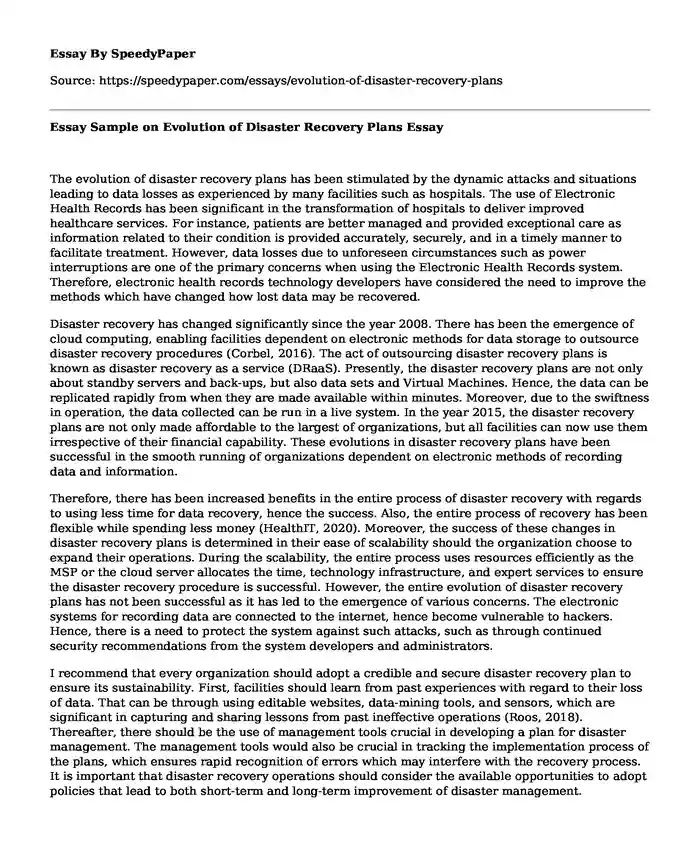
| Type of paper: | Essay |
| Categories: | Data analysis Problem solving Information technologies Software |
| Pages: | 3 |
| Wordcount: | 623 words |
The evolution of disaster recovery plans has been stimulated by the dynamic attacks and situations leading to data losses as experienced by many facilities such as hospitals. The use of Electronic Health Records has been significant in the transformation of hospitals to deliver improved healthcare services. For instance, patients are better managed and provided exceptional care as information related to their condition is provided accurately, securely, and in a timely manner to facilitate treatment. However, data losses due to unforeseen circumstances such as power interruptions are one of the primary concerns when using the Electronic Health Records system. Therefore, electronic health records technology developers have considered the need to improve the methods which have changed how lost data may be recovered.
Disaster recovery has changed significantly since the year 2008. There has been the emergence of cloud computing, enabling facilities dependent on electronic methods for data storage to outsource disaster recovery procedures (Corbel, 2016). The act of outsourcing disaster recovery plans is known as disaster recovery as a service (DRaaS). Presently, the disaster recovery plans are not only about standby servers and back-ups, but also data sets and Virtual Machines. Hence, the data can be replicated rapidly from when they are made available within minutes. Moreover, due to the swiftness in operation, the data collected can be run in a live system. In the year 2015, the disaster recovery plans are not only made affordable to the largest of organizations, but all facilities can now use them irrespective of their financial capability. These evolutions in disaster recovery plans have been successful in the smooth running of organizations dependent on electronic methods of recording data and information.
Therefore, there has been increased benefits in the entire process of disaster recovery with regards to using less time for data recovery, hence the success. Also, the entire process of recovery has been flexible while spending less money (HealthIT, 2020). Moreover, the success of these changes in disaster recovery plans is determined in their ease of scalability should the organization choose to expand their operations. During the scalability, the entire process uses resources efficiently as the MSP or the cloud server allocates the time, technology infrastructure, and expert services to ensure the disaster recovery procedure is successful. However, the entire evolution of disaster recovery plans has not been successful as it has led to the emergence of various concerns. The electronic systems for recording data are connected to the internet, hence become vulnerable to hackers. Hence, there is a need to protect the system against such attacks, such as through continued security recommendations from the system developers and administrators.
I recommend that every organization should adopt a credible and secure disaster recovery plan to ensure its sustainability. First, facilities should learn from past experiences with regard to their loss of data. That can be through using editable websites, data-mining tools, and sensors, which are significant in capturing and sharing lessons from past ineffective operations (Roos, 2018). Thereafter, there should be the use of management tools crucial in developing a plan for disaster management. The management tools would also be crucial in tracking the implementation process of the plans, which ensures rapid recognition of errors which may interfere with the recovery process. It is important that disaster recovery operations should consider the available opportunities to adopt policies that lead to both short-term and long-term improvement of disaster management.
References
Corbel. (2016). The evolution of data backup solutions | Corbel IT Support Solutions. Retrieved 23 January 2020, from https://www.corbel.co.uk/evolution-data-backup-solutions/
HealthIT. (2020). What are the advantages of electronic health records? | HealthIT.gov. Retrieved 23 January 2020, from https://www.healthit.gov/faq/what-are-advantages-electronic-health-records
Roos, A. (2018). Understanding the Different Types of Disaster Recovery Plans | Empower IT Solutions. Retrieved 23 January 2020, from https://www.empowerit.com.au/blog/it-planning/different-types-disaster-recovery-plans/
Cite this page
Essay Sample on Evolution of Disaster Recovery Plans. (2023, Mar 27). Retrieved from https://speedypaper.net/essays/evolution-of-disaster-recovery-plans
Request Removal
If you are the original author of this essay and no longer wish to have it published on the SpeedyPaper website, please click below to request its removal:
- Dissertation Proposal: Impact of ICT on Banking Fraud
- Free Essay Example: Administrative Policy for Tesla, Inc. Consulting Letter
- Revision, Editing, and Proofreading, Free Essay on Writing
- Essay Sample on Some Legal Aspects of Contracts
- Essay Sample on How Much Freedom Should Parents Give to Their Children?
- Paper Example on Cybercrime and Cyber Terrorism Threat Assessment
- Biological Biases - Free Essay Example
Popular categories




